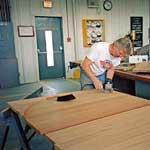- Posts: 15739
- Thank you received: 319
Science Odds and Ends
- ScienceChic
-
 Topic Author
Topic Author
- Mountain Champion
-

*Not everything that I cite will be freely available - if there's something you would like to see in its entirety, let me know and I'll see if I can get it to you!
http://www.sciencemag.org/cgi/content/f ... ietest=yes
News of the Week
Psychology:
Social Savvy Boosts the Collective Intelligence of Groups
Greg Miller
Science 1 October 2010:
Vol. 330. no. 6000, p. 22
DOI: 10.1126/science.330.6000.22
The study: http://www.sciencemag.org/cgi/content/a ... ce.1193147...groups have a "collective intelligence" that predicts their performance on a range of collaborative tasks. They also investigated why some groups appear to be smarter than others. Surprisingly, the average intelligence of the individuals in the group was not the best predictor of a group's performance. The degree to which group members were attuned to social cues and their willingness to take turns speaking were more important, as was the proportion of women in the group.
"social sensitivity" is a key ingredient of successful teams, Woolley says. However, the random makeup of the groups may limit the reach of the findings, cautions Linda Gottfredson, a sociologist who studies intelligence at the University of Delaware, Newark. She notes that the groups were composed of strangers. "It is possible that turn taking in conversation was so important for that reason," she says.
So, despite The Viking's tendencies to post 18 times straight bringing us down
"Now, more than ever, the illusions of division threaten our very existence. We all know the truth: more connects us than separates us. But in times of crisis the wise build bridges, while the foolish build barriers. We must find a way to look after one another as if we were one single tribe.” -King T'Challa, Black Panther
The truth is incontrovertible. Malice may attack it. ignorance may deride it, but in the end, there it is. ~Winston Churchill
Please Log in or Create an account to join the conversation.
- LOL
-

- Mountain Legend
-

- Posts: 6393
- Thank you received: 18
CG suggested starting a science thread in which various science topics were brought up and contained handily in one place for easy retrieval.
OK, but i want to see lots of formulas, charts, pictures, animations and other techno-wizardry..... All text is too boring.
As for the group theory, yep... gotta let everyone speak, the little guys and gals in the trenches usually know what is really going on.
If you want to be, press one. If you want not to be, press 2
Republicans are red, democrats are blue, neither of them, gives a flip about you.
Please Log in or Create an account to join the conversation.
- Rockdoc
-

- Mountain Legend
-

One personal bit of insight comes from working with another geologist on projects for a number of years. We respected one another, had lightly different backgrounds, so we brought sightly different perspectives to the table and the synergy of our collective efforts were ALWAYS better than either one of us could have produced by ourselves. I'm a huge believer in teams, but their "social sensitivity" structure is critical.
Please Log in or Create an account to join the conversation.
- TPP
-

- User is blocked
-

- Posts: 4760
- Thank you received: 0
Edit: Event type: Earthquake Date / time [UTC]: 11/10/2010 - 16:31:10
Country: USA Area: Faulkner County
County / State: State of Arkansas City: -
Cause of event: Unknown Log date [UTC]: 11/10/2010 - 16:31:10
Damage level: Time left: -
Latitude: 35° 6.215 Longitude: 92° 22.882
Dead person(s): N/A Injured person(s): N/A
Missing person(s): N/A Infected person(s): N/A
Evacuated person(s): N/A Affected person(s): N/A
http://hisz.rsoe.hu/alertmap/read/index.php?pageid=seism_read&rid=189549
http://hisz.rsoe.hu/alertmap/read/index.php?pageid=seism_read&rid=189546
NOTE ALL the earthquake up north...
http://hisz.rsoe.hu/alertmap/index2.php?area=usa&lang=eng
Please Log in or Create an account to join the conversation.
- ScienceChic
-
 Topic Author
Topic Author
- Mountain Champion
-

- Posts: 15739
- Thank you received: 319
I can't remember which year (early 2000s?) there was one in southern California that traveled out through the desert to Las Vegas. We were there for a wedding, staying at Circus Circus on the 33rd floor of the 35 story building. Sometime after 2am, I woke up to shaking and major swaying - started to shake hubby awake (who had gone out partying extensively, while I had retired at 10am), telling him "I think I know what's going on but I need a 2nd opinion". He mumbled it was a storm, got up, and staggered (thanks to the ground truly moving underfoot and not the shots from earlier) over toward the windows where the curtains were swaying away from the wall a good 3 feet to prove it only to find no clouds, no lightening, no rain. At that moment the shaking stopped, but the building kept swaying and there was a heart-stopping moment where we weren't sure if it would stop or keep going over! (We found out later it had been built to strict earthquake codes - thank god!). When it started back, we looked at each other, absolutely sober and wide awake, and said let's get the hell outta here! It takes FOREVER to go down 33 flights of stairs with lots of other people. We hung out outside for awhile, decided any aftershocks would be less intense and the building would handle them fine, and went back to bed. The casino on the ground floor was PACKED! Good business for them! That's my fun earthquake experience!
On a side note, if you find yourself in an earthquake, do NOT go toward the window - get under heavy furniture if possible to be protected from collapsing building material. If you're on the 33rd floor, pray the building collapses like an accordian and you land on top - stay in bed to cushion your fall!
http://www.fema.gov/hazard/earthquake/eq_during.shtm
"Now, more than ever, the illusions of division threaten our very existence. We all know the truth: more connects us than separates us. But in times of crisis the wise build bridges, while the foolish build barriers. We must find a way to look after one another as if we were one single tribe.” -King T'Challa, Black Panther
The truth is incontrovertible. Malice may attack it. ignorance may deride it, but in the end, there it is. ~Winston Churchill
Please Log in or Create an account to join the conversation.
- ScienceChic
-
 Topic Author
Topic Author
- Mountain Champion
-

- Posts: 15739
- Thank you received: 319
http://news.sciencemag.org/sciencenow/2 ... ts-in.html
ScienceShot: Social Life Starts in the Womb
by Janelle Weaver on 12 October 2010
The publication: http://www.plosone.org/article/info%3Ad ... ne.0013199Scientists tracked the motion of five pairs of twin fetuses using ultrasonography, an imaging technique that visualizes internal body structures. By the 14 th week of gestation, the fetuses began reaching toward their partners, and just 4 weeks later, they spent more time touching their neighbors than themselves or the walls of the uterus. In all, almost 30% of their movements were directed toward their prenatal companions. These movements, such as stroking the head or back, last longer and are more accurate than self-directed movements, such as touching their own eyes or mouths. The findings suggest that twin fetuses are aware of their counterparts in the womb and prefer to interact with them. Or as the authors put it, they're "wired to be social."
http://news.sciencemag.org/scienceinsid ... first.html
U.S. Stem Cell Trial Treats First Patient
by Jocelyn Kaiser on 12 October 2010
The first approved U.S. clinical trial to use human embryonic stem cells to treat a disease has enrolled its first patient. Geron Corp., which is sponsoring the trial using stem cells for spinal cord injury, announced yesterday that the patient was treated at a hospital in Atlanta. Patients in the study will receive an injection of stem cells at the site of spinal cord damage within 2 weeks after the injury. The small trial is a safety study, but as The Washington Post notes, researchers will also test to see if they benefit from the therapy.
http://news.sciencemag.org/sciencenow/2 ... xplai.html
Economics Nobel: Why Unemployment Is Inevitable
by Adrian Cho on 11 October 2010
High unemployment is now plaguing many nations' economies, but even in the best of times, about one out of every 25 workers will be out of a job. This year's winners of the Sveriges Riksbank Prize in Economic Sciences in Memory of Alfred Nobel laid out the theory that explains why full employment is impossible. Starting in the 1970s [Peter Diamond, Dale Mortensen, and Christopher Pissarides] developed, mostly independently, the theory of markets that suffer "search friction," or costs for consumers and suppliers of a good to find one another. Dubbed the "DMP theory" in the economists' honor, it has become the bedrock for the study of labor markets and explains why people are sure to be out of work even when the number of vacant jobs equals the number of job seekers, so-called equilibrium unemployment. Although the DMP theory started out as a mathematical abstraction, it has become a tool for applied economists and policymakers. That's because it provides a framework for studying in detail the effectiveness of a specific intervention in reducing unemployment or ameliorating its effects.
(water is so cool!)
http://news.sciencemag.org/sciencenow/2 ... -is-a.html
At the Smallest Scale, Water Is a Sloppy Liquid
by Phil Berardelli on 8 October 2010
The publication: http://pubs.acs.org/doi/abs/10.1021%2Fjp1060792Water may seem like a dull liquid. But at the molecular scale, there's a party going on. New simulations reveal that water molecules actually form two different types of structures that break apart and recombine at lightning speeds. Within that mix, the hydrogen atoms form connections that function like hooks, onto which carbon or nitrogen atoms can presumably grab to form the beginnings of complex organic molecules. As far as anyone knows, no other liquid demonstrates this property. The finding introduces "a framework to understand how water with its [hidden structure] influences protein function at the fundamental level,...water is more than just a solvent, but actually an integral part of the functional structure of proteins."
http://news.sciencemag.org/scienceinsid ... .html#more
Universities Are Trying Too Hard to Cash In on Discoveries, Says Academy Panel
by Eliot Marshall on 7 October 2010
The report: http://www.nap.edu/catalog.php?record_id=13001It's been 30 years since Congress revised U.S. patent laws to encourage universities to embrace the world of commerce. Critics predicted that the integrity of academic research would be compromised by patent-grubbing and attempts to build companies around the latest laboratory findings. But such fears did not come true, says a new report from the National Academies released Monday. At the same time, however, the Academies' panel warns universities not to go overboard hunting for patents. Instead, the report says, universities should aim to disseminate technology as widely as possible for the public good.
http://www.cnn.com/2010/OPINION/10/11/e ... =allsearch
How to brand a disease -- and sell a cure
By Carl Elliott
October 11, 2010
Editor's note: Dr. Carl Elliott, an M.D. and Ph.D., is the author of "White Coat, Black Hat: Adventures on the Dark Side of Medicine" (Beacon Press, 2010).
If you want to understand the way prescription drugs are marketed today, have a look at the 1928 book, "Propaganda," by Edward Bernays, the father of public relations in America.
For Bernays, the public relations business was less about selling things than about creating the conditions for things to sell themselves. ...pharmaceutical marketers now sell drugs by selling the diseases that they treat. The buzzword is "disease branding."
To brand a disease is to shape its public perception in order to make it more palatable to potential patients. Once a branded disease has achieved a degree of cultural legitimacy, there is no need to convince anyone that a drug to treat it is necessary. It will come to him as his own idea.
And finally, http://sciencecareers.sciencemag.org/ca ... t.a1000097
Happy 15th Birthday to Us
By Jim Austin
October 08, 2010
Scientific research was a -- or, as many argue, the -- foundation of America's geopolitical and economic success. Changes in the structure of the profession mean changes in the foundation of America's economy, and even in its national security. ...in 2005, the National Academies acknowledged the importance of science in a report, Rising Above the Gathering Storm: Energizing and Employing America for a Brighter Economic Future. Our country's dwindling scientific lead was a national crisis, the report's authors argued. They outlined steps for addressing it.Today marks the 15th birthday of Science's Next Wave (since renamed Science Careers), which I have edited for the past 5 years. "The period from 1950 to 1970 was a true golden age for American science. Young Ph.D.s could choose among excellent jobs, and anyone with a decent scientific idea could be sure of getting funds to pursue it. But, in retrospect, we can see that the golden age was merely the last 20 years of a long period of exponential growth in science that could not possibly be sustained."
In the mid-1990s, when I was a postdoc, a senior colleague related his own golden-age experience. He had six offers right out of grad school, he told me, and many of his classmates shared a similar, happy fate. Contrast this to my own experience, in the same field, some 30 years later: One rejection letter thanked me for being part of " an outstanding cohort" of more than 1300 applicants.
http://www.nap.edu/catalog.php?record_id=11463 Rising Above the Gathering Storm: Energizing and Employing America for a Brighter Economic Future, Published 2007
http://www.nap.edu/catalog.php?record_id=12999 Rising Above the Gathering Storm, Revisited: Rapidly Approaching Category 5, Published 2010
As a birthday gift, I offer a handful of proposals (which do not represent the views of AAAS or Science) on ways to address the storm that, the authors of the new report argue, is now approaching category 5.
--Improve K–12 education: Let's make teaching math and science in the schools a good job for scientists with advanced degrees, as it is in some other countries. Unless you have very good educators, you cannot have good education, and bad jobs do not attract good people.
--Fund far more science: The new Gathering Storm report says that 2004 federal R&D spending was 60% lower than 1964 federal R&D spending as a proportion of the gross domestic product.
--Create more good midlevel jobs in academic research
--Seed endowed chairs for early-career faculty members
--Incentivize scientific investment
"Now, more than ever, the illusions of division threaten our very existence. We all know the truth: more connects us than separates us. But in times of crisis the wise build bridges, while the foolish build barriers. We must find a way to look after one another as if we were one single tribe.” -King T'Challa, Black Panther
The truth is incontrovertible. Malice may attack it. ignorance may deride it, but in the end, there it is. ~Winston Churchill
Please Log in or Create an account to join the conversation.
- TPP
-

- User is blocked
-

- Posts: 4760
- Thank you received: 0
Small Asteroid Zips Close By Earth As Astronomers Watch
A small asteroid passed close by Earth today (Oct. 12), flying within the orbit of the moon while astronomers watched to see if the encounter caused any quakes on the space rock. Oct 12, 2010 - 10:54:26 AM
+++++++++++++++++++++++++++++++++++++++++++++++++++++++++++++++++++++++++++++++++++++
http://news.yahoo.com/s/space/smallasteroidzipsclosebyearthasastronomerswatch
Small Asteroid Zips Close By Earth as Astronomers Watch
Tariq Malik SPACE.com Managing Editor SPACE.com Tue Oct 12, 1:30 pm ET
A small asteroid passed close by Earth today (Oct. 12), flying within the orbit of the moon while astronomers watched to see if the encounter caused any quakes on the space rock.
The asteroid 2010 TD54 made its closest approach to Earth at 6:51 a.m. EDT (1051 GMT), when it passed within about 28,000 miles (45,000 km) of the planet. It was flying over Southeast Asia, near Singapore, at the time. [Photo of Asteroid 2010 TD54 Flyby.]
Astronomers at the Massachusetts Institute of Technology in Boston used a remote link with a NASA Infrared Telescope Facility in Hawaii to observe the small asteroid, which was up to 33 feet (10 meters) across.
Asteroid 2010 TD54 zips by
There was no risk of the asteroid entering Earth's atmosphere or exploding, and it was too small to survive the fiery entry even if it did. But that did not keep astronomers from taking a close look as the space rock sailed by.
"For 2010 TD54, we want to learn its basic composition and to watch whether its close encounter with the Earth causes any changes," astronomer Richard Binzel, a professor of planetary science at MIT, told SPACE.com.
Past studies have shown that close encounters with Earth can cause quakes on nearby asteroids that move surface material around, altering space rocks' appearances.
Asteroid 2010 TD54 was discovered Oct. 9 by astronomers with the NASA-sponsored Catalina Sky Survey in Tucson, Ariz.
Asteroid flybys common
Small asteroids that are previously unknown, like 2010 TD54, often pass by Earth.
An asteroid about 16.5 feet (5 meters) across can be expected to pass Earth inside the orbit of the moon about once a day, NASA scientists said. They typically enter Earth's atmosphere once every two years or so, they added. There are an estimated 30 million unknown asteroids in our solar system.
Bigger asteroids about 460 feet (140 meters) wide can cause widespread damage around their impact sites, but for global devastation much larger space rocks would have to strike Earth.
Binzel said he and his colleagues study asteroids by observing them in visible and near-infrared wavelengths of light, which allows them to determine which minerals are present.
"The presence and strength of mineral absorption bands over these wavelengths allow us to interpret their compositions Ð and directly relate these compositions to known meteorite samples, whenever possible," he said.
NASA regularly tracks asteroids and comets that fly near Earth as part of its Near-Earth Object Observations program, which uses a network of ground and space telescopes. The program has tracked 85 percent of the largest asteroids that fly near Earth and 15 percent of asteroids in the 460-foot class, according to the latest report.
NASA also plans to send astronauts to an asteroid by 2025 under new space plan ordered by President Obama. The mission could help scientists better understand the composition of asteroids, as well as develop better methods of deflecting them before they pose a threat to Earth, space agency officials have said.
Please Log in or Create an account to join the conversation.
- EddieWess
-

- User is blocked
-

- Posts: 204
- Thank you received: 0
Please Log in or Create an account to join the conversation.
- TPP
-

- User is blocked
-

- Posts: 4760
- Thank you received: 0
Please Log in or Create an account to join the conversation.
- ScienceChic
-
 Topic Author
Topic Author
- Mountain Champion
-

- Posts: 15739
- Thank you received: 319
IPCC Meeting Ends, and Pachauri Survives
by Eli Kintisch on 15 October 2010
I'm disappointed that Pachauri isn't stepping down. I think it would do the IPCC a great service to get fresh blood in.The annual meeting http://www.ipcc.ch/meeting_documentatio ... ession.htm of the nations that make up the Intergovernmental Panel on Climate Change (IPCC) ended yesterday in Busan, South Korea, and a few details have trickled out.
Going into the meeting, documents show ( http://www.ipcc.ch/meetings/session32/i ... edures.pdf ), nations wanted IPCC to reform itself along the lines of the recommendations in a report by the InterAcademy Council (IAC). That group, which represents several national science academies, called for a wide range of reforms ( http://reviewipcc.interacademycouncil.n ... lease.html ), including an executive council to handle day-to-day business, rules on how to correct errors, and better procedures for dealing with scientific uncertainties.
http://news.sciencemag.org/sciencenow/2 ... ammar.html
Politicians, Watch Your Grammar
by Nathan Collins on 15 October 2010
A new study indicates that subtle changes in sentence structure can make the difference between whether voters view a politician as promising or unelectable.
In both cases, the perfect aspect—"had an affair" or "removed homes"—conveys a sense that the bad deed is in the past, says Matlock. That may make voters more likely to forgive these actions. On the other hand, imperfect phrases such as "was having an affair" and "was removing homes" suggest that the bad deeds may still be happening and, hence, that the politician is less electable.
Matlock and Fausey saw the disparity only with negative behaviors. When an additional 166 students read perfect and imperfect aspect phrasing about Johnson supporting cancer research, for example, there was no difference in how confident the students were in their judgments of electability. Past research shows that people pay more attention to negative events, Fausey says, so voters may treat them as more important when forming impressions of a politician.
http://news.sciencemag.org/scienceinsid ... minds.html
In China, No Meeting of the Minds on GM Crops
by Li Jiao on 15 October 2010
WUHAN, CHINA—If anyone is under the impression that the Chinese public is ready to embrace genetically modified (GM) crops, they are mistaken. At a hastily arranged session at a symposium here earlier this week, members of the general public berated and quizzed scientists on concerns ranging from the legitimate to the bizarre.
The Chinese government is pushing hard on GM...But the Chinese public is pushing back.
Experts sought to reassure the audience that consumption of GM crops has been linked neither to growth of human wings nor to suppressed sperm levels. But they also acknowledged that there are legitimate questions about the long-term safety of GM foods, both to human health and the environment, that are the subject of ongoing research. "I cannot say that GM food is totally safe," says Zhu Zhen of the Institute of Genetics and Developmental Biology of the Chinese Academy of Sciences (CAS).
http://news.sciencemag.org/scienceinsid ... riety.html
Republicans Charge 'Impropriety' in Halting Yucca Mountain Safety Review
by Eliot Marshall on 14 October 2010
Gettin' really tired of politics interfering in scientific independence...Yesterday, four high-ranking congressional Republicans charged that the independent Nuclear Regulatory Commission (NRC) is playing politics with a technical study of the site, pre-empting legislation enacted by Congress.
One key document in dispute is volume three of an NRC staff member safety evaluation report on the nuclear waste project. It's part of an independent review of a license application filed by the U.S. Department of Energy back in 2008, when DOE still wanted to use Yucca Mountain. Volume three deals with whether the repository could meet long term "post-closure" standards established by NRC to protect the public from radioactive waste. The analysis is complete and rumor has it that it concludes that the Yucca Mountain design meets safety standards. But NRC staff members aren't discussing the contents.
The flap has prompted others, including former NRC Commissioner Kenneth Rogers, to object. Rogers thinks that NRC is being pressured by the Administration to quash the safety review. On 8 October, Rogers wrote to Jaczko and other NRC commissioners saying that he is "deeply concerned that the independence of the Commission and therefore its integrity are under external attack … ."
http://news.sciencemag.org/scienceinsid ... p-a-l.html
Cancer Chief Varmus Draws Up a List of Unsolved Mysteries
by Jocelyn Kaiser on 14 October 2010
Harold Varmus has made a start on one of his first priorities as chief of the U.S. National Cancer Institute (NCI): coming up with a set of key unanswered questions. Last Saturday, Varmus brought together about 25 top researchers and NCI leaders for a brainstorming session on the Bethesda, Maryland, campus.
For example, Varmus says, he'd like to know why testicular cancer can be cured with conventional chemotherapy and why obese people are more prone to certain cancers such as colon and breast cancer. He also wants to upend the conventional wisdom that it's impossible to find drugs that block so-called transcription factors, which are proteins that control the expression of genes.
Next, he wants to set up a Web site where other researchers can add their ideas. And there will likely be more meetings with other disciplines--in particular, behavioral scientists and clinicians were underrepresented last week, Varmus says.
http://news.sciencemag.org/sciencenow/2 ... izzes.html
The Benefits of Pop Quizzes
by Cassandra Willyard on 14 October 2010
No two words fill schoolchildren with more dread than "pop quiz." But mounting evidence suggests that quizzes can help students learn. Now researchers think they know one reason why: Students who take quizzes seem to think up better ways of remembering information than students who simply study.
http://news.sciencemag.org/sciencenow/2 ... cated.html
Deadly Cattle Disease Eradicated
by Dennis Normile on 14 October 2010
Rinderpest, an infectious disease that has wiped out cattle and devastated their keepers for millennia, is gone. The United Nations Food and Agricultural Organization (FAO) announced today in Rome that an eradication effort launched in 1994 has achieved its goal and that fieldwork has ended.
"It is probably the most remarkable achievement in the history of veterinary science," says Peter Roeder, a British veterinarian involved with FAO's Global Rinderpest Eradication Programme (GREP) from its launch in 1994 until he retired in 2007.
http://news.sciencemag.org/scienceinsid ... lture.html
Report: Major Boost in Agricultural Productivity Needed
by Erik Stokstad on 13 October 2010
With global population expected to reach 9.2 billion by 2050, food production will need to double worldwide. Meeting this challenge without causing more environmental damage—cutting down rain forest, for example, or using more groundwater—will be even harder. Farmers do tend to become more productive over time, but a new report http://www.globalharvestinitiative.org/GAP.htm released today finds that they will need to make much more progress—boosting their rate of efficiency gains by 25%.
The report comes from the Global Harvest Initiative, a consortium of large agribusiness companies and global conservation groups, which contracted with the U.S. Department of Agriculture and the Farm Foundation, a non-profit. Fuglie calculated the "total factor productivity" for every country, comparing the amount of food produced with all the inputs needed, such as land, labor, fuel, and chemicals. He found that on average between 2000 and 2007, farm productivity worldwide has been increasing by 1.4% per year.
http://news.sciencemag.org/sciencenow/2 ... s-all.html
Love Conquers All—Even Pain
by Kristen Minogue on 13 October 2010
Maybe love is a drug after all. Researchers rounded up fifteen students still in the throes of passionate romance (dating for 9 months or less) to determine if thinking about a loved one could lessen physical pain. The lovers placed their hands on a small square block, which heated up to cause zero, moderate, or severe pain. Each time, the students were given one of three tasks: look at a photo of their partner, look at a photo of an equally attractive acquaintance, or perform a meaningless distraction task, such as thinking about sports. Seeing the lover's face and distracting themselves decreased pain to roughly the same degree (12% to 13% for severe pain, 36% to 45% for moderate), but they activated different parts of the brain, fMRI scans later revealed. Unlike distraction, looking at the lover's photo activated the reward sections of the brain, such as the amygdala and the nucleus accumbens (red), the researchers report today in PLoS ONE.
http://www.sciencenews.org/view/generic ... t_know_you
Getting to not know you
Young couples are better than long-term partners at discerning each other’s preferences
By Bruce Bower
Thursday, October 14th, 2010
BASEL, Switzerland — Long-lasting marriages may thrive on love, compromise and increasing ignorance about one another. Couples married for an average of 40 years know less about one another’s food, movie and kitchen-design preferences than do partners who have been married or in committed relationships for a year or two, a new study finds.
Two University of Basel psychologists, Benjamin Scheibehenne and Jutta Mata, working with psychologist Peter Todd of Indiana University in Bloomington, observed this counterintuitive pattern in 38 young couples aged 19 to 32, and 20 older couples aged 62 to 78. The greatest gap in partner knowledge was in predicting food preferences, an area with particular relevance to daily life, the scientists report in a paper scheduled to appear in the Journal of Consumer Psychology.
Despite their relative disadvantage in predicting partners’ preferences, long-term couples reported more satisfaction with their relationships than did younger couples.
http://www.sciencenews.org/view/generic ... identified
Guards of the blood-brain barrier identified
Pericytes crucial to protecting central nervous system
By Rachel Ehrenberg
Wednesday, October 13th, 2010
Of all the body’s organs, the brain is the most like Area 51: Entry to the region is severely restricted, thanks to a barricade of cells and molecules known collectively as the blood-brain barrier. Increased surveillance by scientists has now pinpointed the barrier’s senior operatives, cells that are tasked with monitoring the razor wire–like barricade that keeps all but a select few from entering the brain.
In two papers published online October 13 in Nature, scientists report that specialized cells called perictyes are crucial in the blood-brain barrier’s development and its maintenance in adulthood. A better understanding of how these pericytes function could help elucidate why some people fare especially poorly after traumatic brain injury or get particular neurological diseases such as cerebral palsy, scientists say. And new research could also lead to tricks for selectively opening or closing the blood-brain barrier, letting in medications that might combat diseases such as Alzheimer’s.
http://www.sciencenews.org/view/generic ... ighborhood
Climate changes, and there goes the neighborhood
Ranges of rattlers and voles likely to shift drastically with warming
By Susan Milius
Friday, October 15th, 2010
Even if global average temperatures increase by only 1.1 degrees Celsius by 2100, a level of warming considered virtually inevitable by climate scientists, 11 species of rattlesnakes across North America will have to cope with their ranges dislocating by 430 meters per year on average, paleobiogeographer Michelle Lawing of Indiana University in Bloomington said October 10 at the Society of Vertebrate Paleontology’s annual meeting.
She and Polly calculate that during the past 230,000 years, a period that includes three ice ages, rattlesnake ranges have shifted an average of only 2.3 meters annually.
Lawing and Polly estimated how snake ranges varied during past climate dramas by characterizing the temperatures and precipitation patterns that prevail in the species’ ranges today and then figuring out where those conditions would have existed in the past. Rattlesnakes made a good case study, Lawing said, because reptiles depend on their environment for heating and cooling and may be especially sensitive to climate disruptions. Finding relevant snake fossils to study is difficult, Lawing said, but those found so far do fit within the ranges predicted for their time.
Checking the fossil record is important for verifying ideas about past niches, because modeling them rests on assumptions that can go awry, says paleoecologist Rebecca Terry of Stanford University.
http://www.sciencedaily.com/releases/20 ... 133637.htm
Mice That 'Smell' Light Could Help Scientist Better Understand Olfaction
ScienceDaily (Oct. 17, 2010)
Harvard University neurobiologists have created mice that can "smell" light, providing a potent new tool that could help researchers better understand the neural basis of olfaction.
http://www.sciencedaily.com/releases/20 ... 213249.htm
Genetic Test to Predict Early Menopause
ScienceDaily (Oct. 17, 2010)
The first research from the Breakthrough Generations Study could lead to a test to predict a woman's reproductive lifespan. The study from scientists at the University of Exeter Peninsula Medical School and The Institute of Cancer Research (ICR), funded by The Wellcome Trust, tested four genes associated with the menopause. They compared 2,000 women from the Breakthrough Generations Study who had experienced early menopause with a matched group of the same number. The four genes each affected risk of early menopause. In combination, they had a larger impact, which goes towards explaining why some women experience early menopause.
The Breakthrough Generations Study is a large and comprehensive study into the causes of breast cancer and a partnership between Breakthrough Breast Cancer and the ICR. The study will follow the 100,000 UK women participants for the next 40 years to unravel the lifestyle, environmental and genetic factors that cause the disease.
"Now, more than ever, the illusions of division threaten our very existence. We all know the truth: more connects us than separates us. But in times of crisis the wise build bridges, while the foolish build barriers. We must find a way to look after one another as if we were one single tribe.” -King T'Challa, Black Panther
The truth is incontrovertible. Malice may attack it. ignorance may deride it, but in the end, there it is. ~Winston Churchill
Please Log in or Create an account to join the conversation.



